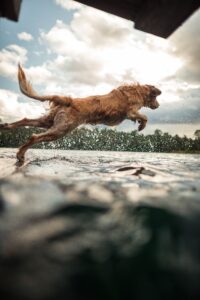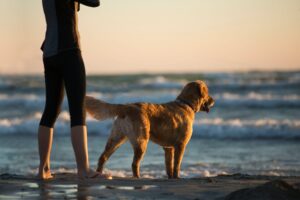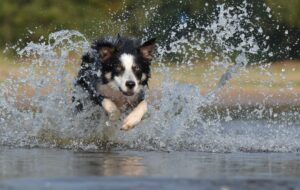Should You Be Cautious of What Kind of Water Your Pup Is Drinking When They Go Outside?
The short answer is “YES”. Some water sources should be avoided, some they can drink in moderation, while others are great sources of safe water. In this article, we will explore the different water sources your dog might encounter, the dangers they pose, and the best ways to keep your pup hydrated and healthy.
How Much Water Should Dogs Drink?
Just like humans, water is an essential life source for dogs. Water prevents dehydration and allows their bodies to function properly. The amount of water a dog needs depends on several factors such as climate, activity level, and diet.
Factors Affecting Water Intake
- Climate: In hotter climates, dogs will need more water to stay hydrated and maintain a healthy body temperature.
- Activity level: Active and working dogs require more water to replace the fluids lost through panting and sweating.
- Diet: Dogs that consume dry kibble will need more water than those on a wet or raw food diet, as these diets have a higher moisture content.
Generally, your dog should drink 1 ounce of water per pound of body weight per day. Keep in mind that water intake can come from their food and other sources, so if your pup is drinking slightly under this amount, you shouldn’t be too concerned. For hard-working dogs, or dogs that drink cold water, or a dog who exercises and then drinks a large amount of water in a short period, they could be at risk for bloat. Learn more about bloat and its dangers in our blog post: Bloat: Why It Is Important
Monitoring Water Intake
It’s essential to monitor your dog’s water intake to ensure they’re staying adequately hydrated. You can do this by:
- Checking their water bowl regularly
- Observing their drinking habits
- Measuring the water they consume each day
Remember, if you notice any significant changes in your dog’s water consumption, it’s essential to consult your veterinarian.
How Do You Know If Your Dog Needs More Water?
Unfortunately, your dog cannot tell you that they are dehydrated, so you will have to discern if they are from a few subtle clues. One easy way to determine if they are dehydrated is to pull up slightly at the base of their neck and letting it go. If the skin drops down quickly and lays flat, then they are hydrated. If the skin stays tented or doesn’t lay back down flat, then that is a good sign that they are dehydrated. If they are at the point that the skin stays tented, their internal organs could also be lacking water and causing damage.
A quicker way to determine if they are dehydrated or the state of their dehydration is to check their gums. If their gums are slightly dry and tacky, this might indicate that they are dehydrated.
Tips for Encouraging Water Intake
- Offer multiple water bowls: Place several water bowls throughout your home to make it more convenient for your dog to drink.
- Make water more appealing: Try adding ice cubes or a splash of low-sodium broth to their water to encourage them to drink more.
- Offer wet food: If your dog is on a dry kibble diet, consider switching to wet food or adding water to their kibble to increase their water intake.
Other Physical Signs of Dehydration:
- Increased heart rate
- Excessive tiredness or dull mental activity
- Wobbling when getting up or while walking
- Gums that appear dark red or pale
- Sunken or dull eyes
*If you notice any of these symptoms, call your veterinarian immediately.
Water Sources
Being aware of the different water sources your dog may encounter is essential for their health and well-being. Here are some common water sources and their potential dangers:

Creek, Pond, River Water
When hiking, trail walking, camping, or visiting a local park, your pup knows where water is nearby. These sources can contain leptospirosis, algae, blue-green algae, and bacteria that can be harmful to them. It is best to avoid these sources of water. Be sure to bring bottled water with you and bring extra if it is an especially hot summer day.
Tips for Safe Drinking on Outdoor Adventures
- Carry a portable water bottle or collapsible bowl for your dog.
- Teach your dog to drink from your hand or a water bottle.
- Use a water purification system if you need to obtain water from a natural source.
Fish Tank Water
If you have fish in a pond in your backyard or an aquarium, this source of water can be harmful to your pet. Yes, your fish tank has a filter, but the chemicals that maintain a constant water pH also make the water unsuitable for your dog. Redirect them to a better, healthier source of water.
Keeping Your Pet Safe Around Aquariums and Ponds
- Create a barrier around your pond or aquarium to prevent your dog from accessing the water.
- Supervise your pet when they are near fish tanks or ponds.
- Train your dog to leave the area if they show interest in drinking from the aquarium or pond.

Ocean Water
Whether you go on vacation to the beach or live near the ocean, the ocean is saltwater. Drinking saltwater will make you and your pet more dehydrated and potentially lead to hypernatremia or sodium deficiency. Bring extra water that is safe for both you and your pet to drink.
Tips for Beach Safety
- Bring a portable water dish and fresh water for your dog.
- Monitor your dog closely to prevent them from drinking ocean water.
- Provide shade and a place to rest for your dog to prevent overheating and dehydration.
Pool Water
If you have a pool at your house or visit your local city/public pool, be aware that pool water can be harmful to your pet. Pools are treated with chemicals such as chlorine and bromine to keep bacteria within safe levels. However, these chemicals also make the water unsafe for your pet. Limit your pet’s exercise in pools, as they are more likely to drink the water while swimming. Have fresh, untreated water nearby so everyone can stay hydrated.
Tips for Pool Safety
- Teach your dog not to drink from the pool and redirect them to their water bowl.
- Supervise your dog when they are near or in the pool.
- Rinse your dog off after swimming in the pool to remove chemicals from their fur and skin.

Rainwater
Rainwater can collect in puddles from a variety of sources, such as a garden hose, downspout, or runoff from the street. Any water that collects on a hard concrete surface can be contaminated with lime, oil, and raw chemicals, which can poison your pet. Although water from a garden hose is safe to drink, the safety depends on the time and duration it has been on the surface or if it is coming directly from the hose.
Tips for Preventing Rainwater Consumption
- Redirect your dog from puddles and standing water.
- Provide fresh water inside or in a covered area to prevent contamination from rainwater.
- Monitor your dog when they are outside during or after rain to ensure they don’t drink contaminated water.
Community Water Bowls
If you frequent dog parks or pet-friendly businesses, you might see community water bowls available for dogs to drink from. While these can be convenient, they also pose a risk. Community water bowls can harbor bacteria and parasites, which can make your dog sick.
Tips for Avoiding Community Water Bowls
- Bring your own portable water dish and fresh water for your dog.
- Teach your dog not to drink from shared water sources.
- If you must use a community water bowl, clean it with soap and water or a pet-safe disinfectant before use.
Leptospirosis
Leptospirosis is a bacterial infection that can affect both humans and animals, including dogs. The disease is caused by the bacteria Leptospira, which is found in soil, water, and the urine of infected animals. This infection can cause severe kidney and liver damage, and in some cases, it can be fatal.
Transmission and Symptoms
Dogs can contract leptospirosis by coming into contact with contaminated water, soil, or the urine of infected animals. This can happen when a dog drinks, swims in, or walks through contaminated water. The bacteria can enter the body through the skin, especially if there are cuts or abrasions, or through the mucous membranes (eyes, nose, and mouth).
Symptoms of leptospirosis in dogs can vary, but common signs include:
- Fever
- Vomiting
- Diarrhea
- Loss of appetite
- Lethargy
- Jaundice (yellowing of the skin and eyes)
- Increased thirst and urination
- Swollen lymph nodes
Diagnosis and Treatment
If you suspect your dog may have leptospirosis, it’s essential to consult with your veterinarian as soon as possible. The vet will perform a physical examination, and laboratory tests will be conducted to confirm the diagnosis.
Treatment for leptospirosis typically involves antibiotics to target the bacteria, as well as supportive care to manage the symptoms and any complications that may arise. This may include fluid therapy, pain management, and medications to protect the liver and kidneys.
Prevention
To prevent leptospirosis in dogs, consider the following steps:
- Vaccinate your dog against leptospirosis, especially if you live in an area where the infection is prevalent or if your dog frequently spends time in outdoor environments with potential exposure to contaminated water.
- Prevent your dog from drinking from or swimming in stagnant water, ponds, or streams, which may be contaminated with the bacteria.
- Control rodent populations around your home, as rodents can be carriers of the disease.
Algae
Algae are simple, plant-like organisms that can grow in both freshwater and saltwater environments. While many types of algae are harmless, some can produce toxins that are dangerous to humans, pets, and wildlife.
Harmful Algal Blooms
Harmful algal blooms (HABs) occur when certain types of algae grow rapidly and produce toxins. These blooms can form in various bodies of water, including lakes, ponds, and rivers. HABs can pose a threat to dogs if they drink from, swim in, or come into contact with the contaminated water.
Symptoms of Algae Toxicity in Dogs
Symptoms of algae toxicity in dogs can vary depending on the type of toxin involved. Some common symptoms include:
- Vomiting
- Diarrhea
- Weakness
- Difficulty breathing
- Seizures
- Coma
- Death
Treatment and Prevention
If you suspect your dog has been exposed to toxic algae, seek immediate veterinary attention. Treatment may include supportive care, such as fluid therapy, oxygen supplementation, and medications to manage symptoms and potential complications.
Preventing algae toxicity in dogs involves:
- Keeping your dog away from water bodies with visible algal blooms.
- Monitoring local news and public health advisories for reports of harmful algal blooms in your area.
- Teaching your dog not to drink from or swim in stagnant water, ponds, or streams.
Blue-Green Algae
Blue-green algae, also known as cyanobacteria, are microscopic organisms found in freshwater and saltwater environments. Some species of blue-green algae can produce toxins, which can be harmful or even fatal to dogs if ingested.
Symptoms of Blue-Green
Algae Toxicity in Dogs
If your dog is exposed to toxic blue-green algae, symptoms can appear within minutes or hours of exposure. These symptoms can include:
- Vomiting
- Diarrhea
- Weakness
- Difficulty breathing
- Tremors
- Seizures
- Coma
- Death
Treatment and Prevention
If you suspect your dog has ingested toxic blue-green algae, seek immediate veterinary attention. Treatment typically involves supportive care, such as fluid therapy, oxygen supplementation, and medications to manage symptoms and potential complications.
Preventing blue-green algae toxicity in dogs involves:
- Keeping your dog away from water bodies with visible algal blooms or known blue-green algae contamination.
- Monitoring local news and public health advisories for reports of harmful algal blooms in your area.
- Teaching your dog not to drink from or swim in stagnant water, ponds, or streams.
Bacteria
Bacteria are microscopic, single-celled organisms that can be found in various environments, including soil, water, and the bodies of humans and animals. While many bacteria are harmless or even beneficial, some can cause illness in dogs if ingested or come into contact with open wounds.
Common Bacteria Affecting Dogs
Some common types of bacteria that can cause illness in dogs include:
- Salmonella: This bacteria can be found in contaminated food or water and can cause gastrointestinal illness in dogs.
- Campylobacter: This bacteria can be found in contaminated water, raw meat, and feces and can cause diarrhea in dogs.
- E. coli: This bacteria can be found in contaminated water, raw meat, and feces and can cause gastrointestinal illness in dogs.
- Clostridium: This bacteria can be found in contaminated soil, water, and feces and can cause gastrointestinal illness in dogs.
Symptoms of Bacterial Infections in Dogs
Symptoms of bacterial infections in dogs can vary depending on the type of bacteria involved and the severity of the infection. Some common symptoms include:
- Vomiting
- Diarrhea
- Loss of appetite
- Lethargy
- Fever
- Dehydration
Treatment and Prevention
If you suspect your dog has a bacterial infection, consult your veterinarian for an accurate diagnosis and appropriate treatment. Treatment typically involves antibiotics to target the specific bacteria, as well as supportive care to manage the symptoms and any complications that may arise.
To prevent bacterial infections in dogs:
- Keep your dog away from contaminated water sources and teach them not to drink from stagnant water, ponds, or streams.
- Practice good hygiene, such as washing your hands before handling your dog’s food or water and cleaning their food and water dishes regularly.
- Ensure your dog’s vaccinations are up-to-date and follow your veterinarian’s recommendations for routine preventive care.
It’s essential to be aware of the potential dangers posed by leptospirosis, algae, blue-green algae, and bacteria in the water sources your dog may encounter. By taking preventive measures, monitoring your dog’s behavior, and seeking prompt veterinary care if you suspect an issue, you can help protect your dog from these water-related health risks. It’s also essential to be cautious about the water your dog drinks when they go outside. By providing fresh, clean water for your pup and monitoring the water sources they encounter, you can ensure they stay hydrated and healthy. Additionally, teaching your dog to avoid drinking from potentially contaminated sources and providing safe alternatives can help protect them from dangerous water-related health issues. Remember, when in doubt, consult with your veterinarian about your dog’s hydration needs and any concerns you may have.
Sources
American Kennel Club. (n.d.). What is leptospirosis? Can dogs get leptospirosis? American Kennel Club. Retrieved March 25, 2023, from https://www.akc.org/expert-advice/health/what-is-leptospirosis-can-dogs-get-leptospirosis/\
